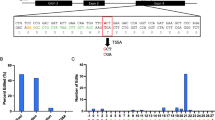Abstract
Backgrounds
The differences of DNA mutation patterns of genome editing by CRISPR (Clustered regularly interspaced Short Palindromic Repeats)-Cas9 and CRISPR-Cpf1 is not completely understood.
Methods
CRISPR-Cas9 or CRISPR-Cpf1 is applied for genome editing at the exact same four genomic locations in human embryonic kidney 293T (HEK293T) cells. The mutation patterns of the target genomic loci were analyzed by targeted deep sequencing.
Results
The mutation patterns of CRISPR-Cas9 and CRISPR-Cpf1 showed prominent differences. CRISPR-Cpf1 mediated genome engineering almost always resulted in deletion, while CRISPR-Cas9 showed remarkably high rate of insertion mutation of 1 base pair. The deletion patterns of CRISPR-Cas9 and CRISPR-Cpf1 were also different. The deletion patterns of CRISPR-Cas9 were composed of diverse and evenly distributed deletion patterns, while the mutation patterns of CRISPR-Cpf1 were composed of fewer major patterns.
Conclusion
Genome editing by CRISPR-Cas9 and CRISPR-Cpf1 shows different characteristics.
Similar content being viewed by others
References
Wright, A. V., Nunez, J. K. & Doudna, J. A. Biology and Applications of CRISPR Systems: Harnessing Nature’s Toolbox for Genome Engineering. Cell 164, 29–44, doi:https://doi.org/10.1016/j.cell.2015.12.035 (2016).
O’connell, M. R. et al. Programmable RNA recognition and cleavage by CRISPR/Cas9. Nature 516, 263 (2014).
Cho, S. W., Kim, S., Kim, J. M. & Kim, J.-S. Targeted genome engineering in human cells with the Cas9 RNA-guided endonuclease. Nature Biotechnology 31, 230 (2013).
Jiang, W., Bikard, D., Cox, D., Zhang, F. & Marraffini, L. A. RNA-guided editing of bacterial genomes using CRISPR-Cas systems. Nature Biotechnology 31, 233 (2013).
Kim, Y. S. & Ko, J. H. Humanized model mice by genome editing and engraftment technologies. Mol Cell Toxicol 14, 255–261, doi:https://doi.org/10.1007/s13273-018-0028-y (2018).
Zetsche, B. et al. Cpf1 is a single RNA-guided endonuclease of a class 2 CRISPR-Cas system. Cell 163, 759–771 (2015).
Hur, J. K. et al. Targeted mutagenesis in mice by electroporation of Cpf1 ribonucleoproteins. Nature Biotechnology 34, 807 (2016).
Kleinstiver, B. P. et al. Genome-wide specificities of CRISPR-Cas Cpf1 nucleases in human cells. Nature Biotechnology 34, 869 (2016).
Kim, D. et al. Genome-wide analysis reveals specificities of Cpf1 endonucleases in human cells. Nature Biotechnology 34, 863 (2016).
Bortesi, L. et al. Patterns of CRISPR/Cas9 activity in plants, animals and microbes. Plant Biotechnology Journal 14, 2203–2216 (2016).
Kim, Y., Kweon, J. & Kim, J.-S. TALENs and ZFNs are associated with different mutation signatures. Nature Methods 10, 185 (2013).
Kim, H. & Kim, J.-S. A guide to genome engineering with programmable nucleases. Nature Reviews Genetics 15, 321 (2014).
Bae, S., Kweon, J., Kim, H. S. & Kim, J. S. Microhomology-based choice of Cas9 nuclease target sites. Nature Methods 11, 705–706, doi:https://doi.org/10.1038/nmeth.3015 (2014).
Shen, M. W. et al. Predictable and precise template-free CRISPR editing of pathogenic variants. Nature 563, 646–651 (2018).
Acknowledgements
This work was supported by the National Research Foundation (NRF) of Korea funded by the Ministry of Science & ICT (NRF-2017R1D1A1B030 35094, NRF-2017R1E1A1A01074529, NRF-2018M3A9H 3021707 to J.K.H., NRF-2017R1D1A1B03035760, NRF-2019R1C1C1010602 to J.W.H., NRF-2018R1A5A2023 879 to G.S., and 2014M3C7A1062896 to W.C.H.).
Author information
Authors and Affiliations
Contributions
T.B., J.W.H., and J.K.H designed the experiments and analyzed the results. T.B. conducted the experiments, W.C.H., D.L, and G.S conducted the computational analyses of the data. All authors contributed to writing of the manuscript.
Corresponding authors
Additional information
Conflict of Interest
Taegeun Bae, Woo Chang Hwang, Dohyeon Lee, Giltae Song, Junseok W Hur, and Junho K Hur declare that they have no conflict of interest.
Human and animal rights
This article does not include any research on humans and animals, and has it been carried out in accordance with the institutional and national guidelines.
Rights and permissions
About this article
Cite this article
Bae, T., Hwang, W.C., Lee, D. et al. Characterization of distinct mutation patterns by CRISPR-Cas9 and CRISPR-Cpf1 genome editing systems. Mol. Cell. Toxicol. 15, 383–389 (2019). https://doi.org/10.1007/s13273-019-0041-9
Received:
Accepted:
Published:
Issue Date:
DOI: https://doi.org/10.1007/s13273-019-0041-9




